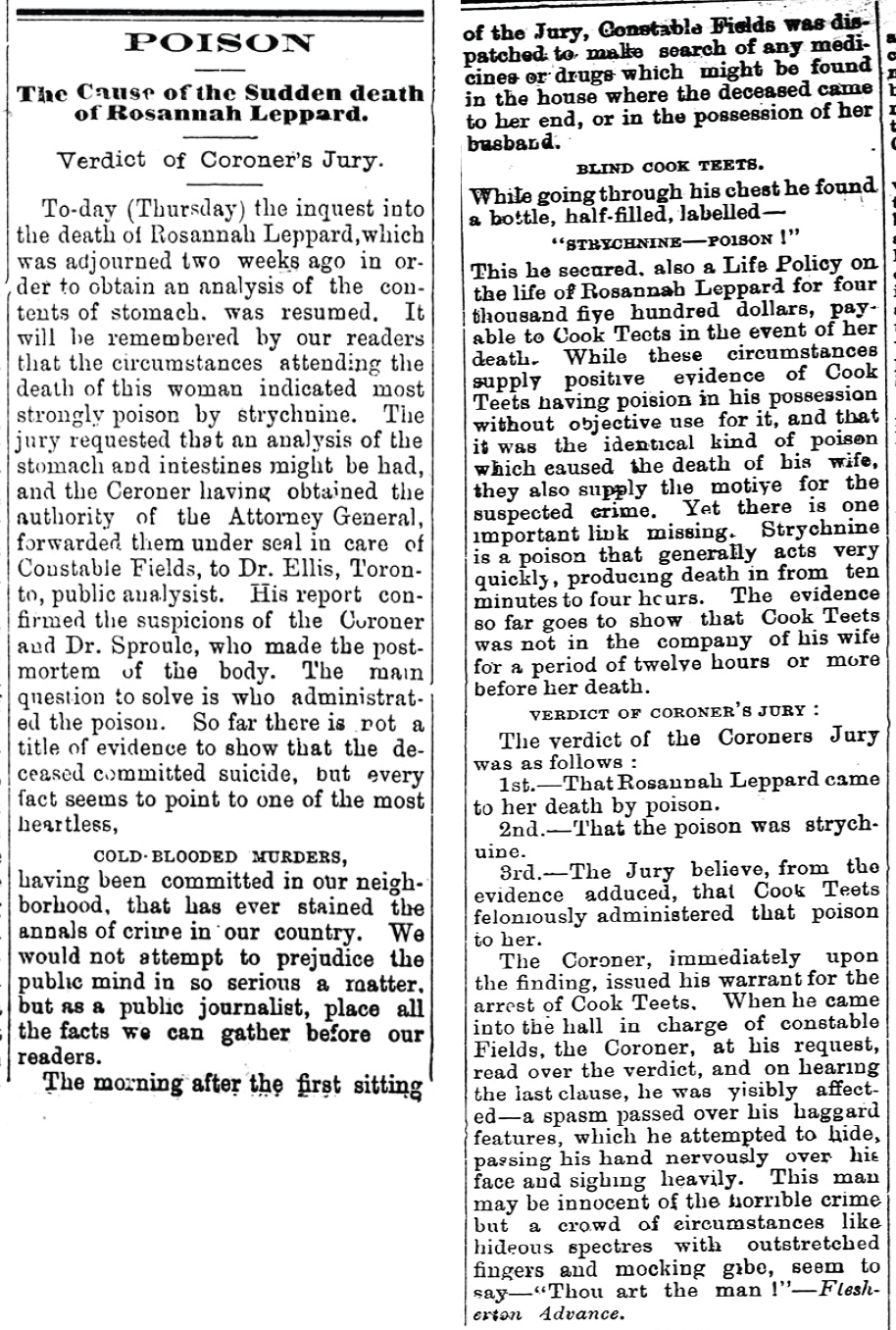
Postcript: Another Thought
Cook Teets was the first but not the last man to be hanged in Owen Sound. That dubious honour goes to Frederick Bussey, who was executed in 1948. From Confederation in 1867 to the last hanging in Canada in 1962, some seven hundred men and thirteen women died on the gallows. Capital punishment was abolished by Parliament in 1976.
We have no idea how many Canadians may have been unjustly hanged. Since the abolition of hanging, numerous persons convicted of murder have later been found innocent. They range from David Milgaard who served twenty-three years in prison and won $10 million in compensation, to Guy Paul Morin who spent eighteen months behind bars and was awarded $1.25 million for his wrongful incarceration.
The fact innocent people continue to be convicted of serious offences does not, however, seem to have blunted Canadians’ support for capital punishment. An Angus Reid survey in 2012 showed 62 per cent in favour of capital punishment for murder, although this figure drops to 50 per cent when life imprisonment is offered as an alternative. A 2016 Abacus Data survey reported 58 per cent of Canadians regard capital punishment as “morally right.”
Approval of the death penalty had stood at a low of 44 per cent in 2005. The rise since then may be partially a consequence of the Stephen Harper government’s insistent drum beating between 2006 and 2015 for harsher penalties against lawbreakers. Fortunately, there appears to be no political will in Canada to reopen the question of capital punishment.
A compliant media may also bear some responsibility. It is cheap and convenient to play up crime – even petty crime – creating an impression that wrongdoing is more prevalent than is actually the case. Violent crime in Canada has been on the decline for several decades. Statistics Canada reported that in 2014, the violent crime rate was five per cent lower than in 2013 and twenty-six per cent lower than a decade earlier.
On any given day there is an average of 36,845 adults housed in Canada’s provincial or federal jails. This cost Canadian taxpayers $4.6 billion in 2013/14. About one in three have been convicted of no crime; they are on remand, awaiting trial. Most are younger adults, and one in four of those in provincial institutions is of aboriginal descent, a rate far in excess of their proportion of the population. Canada’s federal penitentiaries, where offenders serve sentences of longer than two years, house some 15,000 prisoners.
But there are more grim conclusions. According to federal Correctional Investigator Howard Sapers in his 2013 report, changes that saw inmates serve longer sentences, together with cuts in prison pay and imposition of austere conditions did little to improve public safety; instead, he says it made it more difficult to rehabilitate and reintegrate prisoners back into society upon their release. The Supreme Court has set aside some of these laws as unconstitutional, and it is likely the federal government will repeal or amend others.
When Prime Minister Justin Trudeau took office in November, 2015, he issued a series of mandate letters to his cabinet ministers, setting out his expectations for each of them. The Justice Minister was mandated to reform use of solitary confinement and review changes made by the Harper government. The letter, however, was silent on whether we should continue to jail people who have not committed violent crimes. More than three-quarters of all criminal charges (360,000 in 2013/14) are for non-violent offences. About one-third of those found guilty end up serving jail terms. With so many alternatives to prison available – including fines, probation, and conditional sentences – is there really any reason so many of these non-violent offenders need to be behind bars, each at a cost to taxpayers of more than $100,000 per year? This warrants the urgent attention of Ottawa’s committee of experts on justice reform.
Conditional sentences, allowing terms to be seved in the community rather than in jail, came into effect in 1996. They offer a process that many consider the best alternative to imprisonment. Judges cannot apply conditional sentences in cases requiring mandatory minimum sentences. As a result, their latitude was greatly reduced by the sixty new mandatory minimum prison terms enacted between 2006 and 2015 for drugs, guns, sex offences and many non-violent crimes. In most situations, these minimums are a barrier to the principle of making the penalty fit the circumstances of the individual offender. They should be repealed.
Governments can take these steps while recognizing the harm done to victims and the need to keep society safe. In fact, the best way of encouraging released prisoners to lead useful lives is not by extending their periods in jail or otherwise penalizing them, but through education, treatment of mental illness, and by offering assistance in their reintegration into society.
Some judges have declined to comply with minimum sentences, asserting they constitute “cruel and unusual punishment.” In one case, a judge refused to apply the mninimum six months for possession of between six and two hundred marijuana plants for the purpose of trafficking. With legalization of marijuana in Canada, the high number of arrests on related charges – 75,000 in 2013 – will no longer occur.
If people are not sent to jail, will they not simply be encouraged to repeat their crimes? Unfortunately this is what is happening now, as seen in the statistics for rearrests of people for repeat offences. Nothing has been achieved by imprisoning them. The John Howard Society warns that prisoners are facing longer periods of incarceration and are receiving less support and supervision through parole as they return to their communities. “This approach,” it concludes, “makes communities less safe.”
The cost of providing counselling and moral and educational support to keep people out of jail need be no greater – probably less – than what is now spent to keep them in jail. The return to society in the form of rebuilt lives and reduced crime will be immeasurably greater.

Excerpt Markdale Standard (November 2, 1883)

Excerpt Flesherton Advance (November 6, 1884)

Excerpt Flesherton Advance (December 11, 1884)